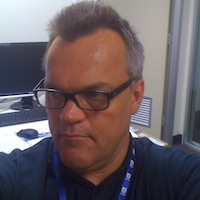A brief review of the paper:
Disturbances in slow-wave sleep (SWS) are induced by models of bilateral inflammation, neuropathic, and postoperative pain, but not osteoarthritic pain in rats. [1]
Part 2 of 3: critique of the study
Closer examination of the data provided shows that the greater the reduction in percentage of SWS2 (deeper SWS) appears to have a relationship with an increase in the percentage of SWS1 (lighter SWS) and/or a reduction in the percentage of Total SWS. To put these changes into context, it should be noted that humans and rats do not simply have a wake period and two distinct SWS states. Humans specifically, also have a couple of relatively lighter stages of sleep than SWS, including a stage 1 sleep, a stage 2 sleep and a REM sleep stage. The inference here is that the reduction in SWS2 (deeper SWS) is taken up with more SWS1 (lighter SWS) and possibly, an increase in the lighter stages of sleep (sleep stages1 & 2) through a mechanism that is sensitive enough to register noxious stimuli and disturb sleep architecture. The researchers offer that it would be anthropomorphising to infer that the injured animals were experiencing a “restless sleep”, however, they also refer to another study in which injured rats displayed “significant levels of sleep fragmentation”. As these animals can exhibit a pain response, sleep, and have sleep architecture altered due to noxious stimuli, why is there is little reason to believe that their injuries could induce a restless sleep?
Insomnia and sleep fragmentation are the likely expressions of changes in sleep architecture due to noxious stimuli. In the study under review, the authors report the percentage change in SWS from pre-injury baseline, but not the actual measure of SWS in minutes. This approach limits our ability in determining how much sleep loss is accounted for by an insomnia type deficit, whereby sleep onset or returning to sleep after awakening, is delayed due to noxious stimuli. Arousals during sleep reduce the amount and percentage of SWS through either disturbing sleep into a lighter stage or by waking the animal. The methodology employed by this study also prevents further scrutiny for arousals as an EEG epoch was classified in this study as SWS only when the ten second average exceeded that of waking levels using Fast Fourier Transforms. This is problematic as arousals can last for only a couple of seconds, however, averaging out the EEG in the manner used in this study omits their detection and any transition to lighter stages of sleep. It could be argued that arousals from sleep were accounted for in this study with movement during sleep periods excluded from the analysis, and that further, movement during sleep periods only accounted for less than 1% of the data. However, movements associated with arousals are usually related to the cause of the arousal such as in Periodic Limb Disorder (twitching) and Obstructive Sleep Apnoea Syndrome (choking and breathing), which are not features in the pathological conditions emulated in these rats. Furthermore, while noxious stimuli may be sufficient to disturb SWS to a lighter sleep stage, the percentage of arousals that fully awaken the animal could be small and subsequently, only result in minor increases in movement during sleep.
In order to produce arousals in a rat, or human for that matter, noxious stimuli must be neurologically processed. If we are to look at noxious stimuli presented during sleep as a mainly physiological process, we would primarily observe a reduction in cerebral processing of noxious stimuli during this period. However, reduced does not infer that the perception of noxious stimuli in the somatosensory cortex is absent. Sleep is not an unconscious state or coma, whereby one could be stuck with a pin during sleep without response. Though diminished, the ability to perceive and respond to pain is still active. Bastuji et al. (2008) reports that in their study using human participants, nociceptive stimuli induced via laser stimuli of 15-20dB over sensory threshold produced arousals or awakenings in 30% of cases. This group further reports that sleep induced a decrease in the amplitude of EEG responses to noxious stimuli. The EEG responses were not only drastically reduced in amplitude, but also had a shorter latency during Stage 2 and REM than during waking state. Bastuji et al, (2008) suggest that a selective occlusion of some late subcomponents during sleep and may reflect the loss or automatic orienteering reactions toward the stimulus [2].
The contribution of arousals in reducing the percentage of SWS, however, does not answer additional questions about the study under review which bear further scrutiny. These include; “why was there such a large degree of diversity in SWS outcomes associated with the 4 distinct conditions?” and “why was the osteoarthritis condition the least disturbing to SWS”? It is conceivable that differing types of injuries used in this study would have some inherent variation in the amounts of noxious stimulation they would promote. For example, there would be differences in the time taken for the differing injuries to heal, differences in their physical features such as position and associated variations involved in bodily movement, anxiety components associated with the injury due to its effect of functionality, etc. Perhaps the noxious stimuli associated with the inflammatory, neuropathic and post-operative conditions were either more frequent or stronger than those occurring through the osteoarthritic condition. Regardless, the impact of the each condition on the percentage of SWS is still unclear and requires further investigation.
Previous post: summary of disturbances in slow-wave sleep
Up next: how would humans be affected by reduced slow-wave sleep?
About Danny Camfferman
 Danny has over 16 years’ experience working in the area of sleep disorders, both as a researcher and in their clinical assessment at the Adelaide Institute for Sleep Health and the Women’s and Children’s Hospital. His research on both children and adults has identified compliance issues related to the treatment of Obstructive Sleep Apnoea Syndrome (OSAS) and on excessive daytime sleepiness associated with Prader-Willi Syndrome, a complex genetic disorder. He completed his PhD on the effects of childhood eczema on sleep quality and subsequent secondary deficits in neurocognitive functioning and daytime behaviour. He has recently undertaken a Research Fellowship with the Body in Mind Group to investigate Chronic Pain through EEG methodologies. Danny is married to Yoko and they have an eight year old daughter, Niko. Together, they enjoy martial arts, particularly Iaido, camping, movies, furniture restoration, good food and their garden.
Danny has over 16 years’ experience working in the area of sleep disorders, both as a researcher and in their clinical assessment at the Adelaide Institute for Sleep Health and the Women’s and Children’s Hospital. His research on both children and adults has identified compliance issues related to the treatment of Obstructive Sleep Apnoea Syndrome (OSAS) and on excessive daytime sleepiness associated with Prader-Willi Syndrome, a complex genetic disorder. He completed his PhD on the effects of childhood eczema on sleep quality and subsequent secondary deficits in neurocognitive functioning and daytime behaviour. He has recently undertaken a Research Fellowship with the Body in Mind Group to investigate Chronic Pain through EEG methodologies. Danny is married to Yoko and they have an eight year old daughter, Niko. Together, they enjoy martial arts, particularly Iaido, camping, movies, furniture restoration, good food and their garden.
References
[1] Leys LJ, Chu KL, Xu J, Pai M, Yang HS, Robb HM, Jarvis MF, Radek RJ, & McGaraughty S (2013). Disturbances in slow-wave sleep are induced by models of bilateral inflammation, neuropathic, and postoperative pain, but not osteoarthritic pain in rats. Pain, 154 (7), 1092-102 PMID: 23664655
[2] Bastuji H, Perchet C, Legrain V, Montes C, & Garcia-Larrea L (2008). Laser evoked responses to painful stimulation persist during sleep and predict subsequent arousals. Pain, 137 (3), 589-99 PMID: 18063478



